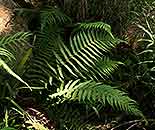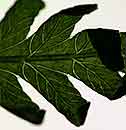Amauropelta bergiana (Schltdl.) Holttum var. bergiana
Synonyms |
Nephrodium bergianum (Schltdl.) Baker |
|---|---|
Common name |
|
Description |
Rhizome erect, suberect; rhizome scales up to 8 mm long, lanceolate, brown, subentire, sparsely ciliate. Fronds monomorphic, tufted, arching, not proliferous, herbaceous. Stipe up to 32 cm long, strawcoloured to greyish brown, with minute white hairs and with scales similar to those on the rhizome near the base. Lamina deeply 2-pinnatifid, narrowly elliptic in outline, apex tapering to a point, lower pinnae gradually reduced and widely spaced, with usually 1 pair of very small, vestigial pinnae, 30-95 × up to 26 cm; pinnae narrowly oblong-acuminate, 7.5-16 × 1.5-2.5 cm; undersurface with short, pale hairs, many of which are hooked, upper surface with short, straight hairs; ultimate lobes oblong, apex rounded, margins entire, 8-10 x 4 mm; veins 8-10 pairs, not meeting the veins of the adjacent lobes; rhachis pale brown, with scattered hooked hairs below. Sori numerous, small, rounded, submarginal on the veins; indusia small, with few hairs, lost at maturity. |
Notes | A. oppositiformis resembles A. bergiana but is found in high-altitude grassland and has straight hairs and golden to red glands on the lamina below. |
Derivation | bergiana: named after C.H.Bergius (1790-1818), German botanist. |
Habitat | Streambanks in forest and moist areas along forest margin, bamboo-podocarpus, rock caves in Erica forest. |
Distribution worldwide | Africa, Mascarene Isl. |
Distribution in Africa |
Angola, Burundi, Cameroon, Equatorial Guinea (incl. Bioko), Kenya, Malawi, Mozambique, Nigeria, Rwanda, South Africa, Sudan and South Sudan, Swaziland, Tanzania , Zambia, Zimbabwe. |
Growth form |
Terrestrial. |
Literature |
|



